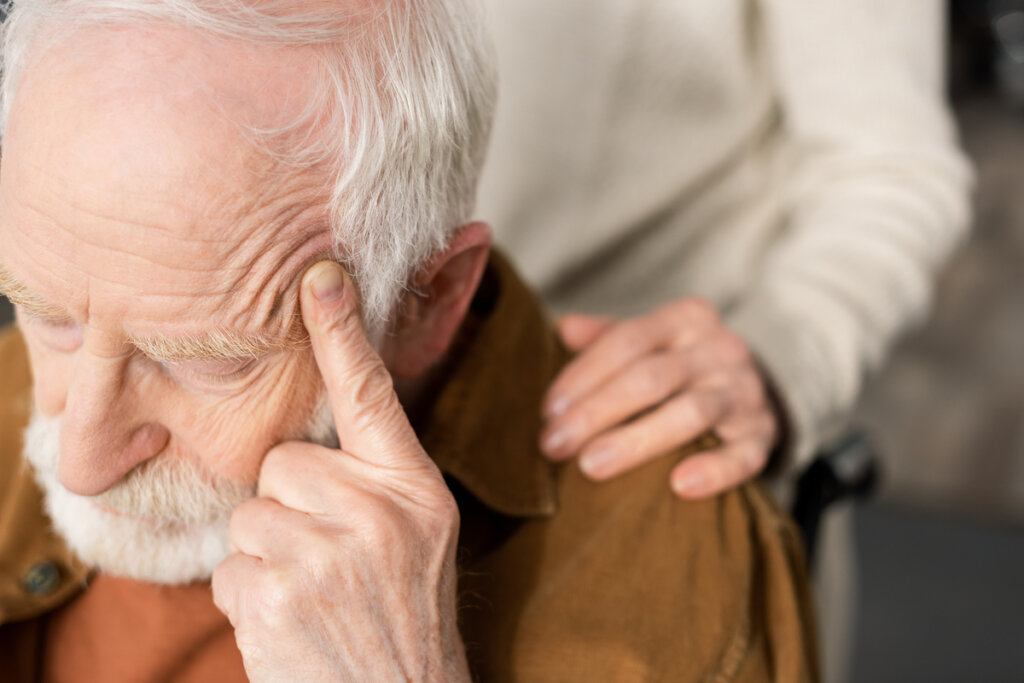Discrimination Against the Elderly: An All Too Frequent Reality


Written and verified by the psychologist Valeria Sabater
It’s called ageism and it occurs every moment of every day. In fact, discrimination against the elderly is a reality that has no borders. Nor does it only occur in certain settings or cultures. Moreover, curiously, we’ve been educated to identify sexism and racist behavior, but age discrimination is something we don’t always recognize. Yet, we frequently practice it.
As a matter of fact, a recent report from the World Health Organization (WHO) explains that one in two people in the world engage in discriminatory behavior toward the elderly. This data is shocking and begs for serious reflection. Indeed, to think that half the planet has criticized, underestimated, or belittled an elderly person debases us as a society.
However, this phenomenon isn’t new. It’s just that, today, it’s become more evident than ever. The health crisis in which we found ourselves due to the pandemic brought to light certain situations that are both extremely sad and unfair. So, now, more than ever, we need to become aware and apply changes and develop strategies that mean that age, far from being a problem, becomes a bonus.
“Growing older is like climbing a mountain, the higher you get, the more strength you need, but the further you can see.”
-Ingmar Bergman-

Discrimination against the elderly
Ageism or discrimination against the elderly was first studied in 1968. It manifests in how we think (stereotypes), how we feel (prejudices), and how we act (discrimination).
It was Robert Neil Butler, a physician, gerontologist, and psychiatrist who emerged as the pioneer par excellence in the field of research and defense of the elderly community.
His book, Human Aging, continues to be a reference for understanding the discriminatory practices that occur at the individual, social, and institutional levels. This phenomenon has been going on for decades. But, as the WHO report rightly points out, we’re currently seeing new dynamics we must take into account.
Countries with higher incomes are more likely to discriminate
In the analysis that the WHO conducted on the World Values Survey, it became clear that countries with high incomes have a lower degree of respect for older people. This lack of consideration concerns thoughts and stereotypes regarding the elderly.
Somehow, we unconsciously let ourselves be carried away by certain thought schemas and prejudices that we don’t even question. The same thing happens with sexism. But, discrimination against the elderly is a contradiction in terms. Because it’s estimated that, by 2050, the number of people over the age of 60 will reach 2 billion.
We’re an increasingly aging society and yet we continue to harbor a negative perception of this sector of the population.
Discrimination against the elderly and the ideas we reinforce
The University of Alberta (Canada) conducted a study in 2019 in which they demonstrated the degree of discrimination against the elderly. Donna Wilson, the author of this study, points out that ageism against older people is the most common form of prejudice and a problem that we’re often not aware of. Nor are we aware of its prevalence or its impact.
You might wonder how and in what way this phenomenon manifests. To begin with, age discrimination is related to the thoughts we have toward the elderly, as well as our feelings and judgments. For example:
- We might think that the elderly aren’t capable of learning new things and are incapable of using cell phones and computers etc.
- We tend to conceive of them as invalid. In fact, we see them as only destined to be cared for by others.
- We take it for granted that they can’t hear well and don’t understand.
- We assume that they’re no longer useful to society.
- They’re not represented in the world of film and television.
- Ageism also translates into architectural barriers. For instance, cities aren’t enabled for the elderly.
- Nudity and intimacy among older people are considered to be taboo. Therefore, their sexuality is stigmatized.
- Institutional ageism is also rife. For example, the elderly aren’t given job opportunities even though they may want to continue working. They also frequently find themselves in positions of vulnerability in residential homes.

The psychological impact of discrimination
Ageism goes way beyond a simple prejudice or a negative thought. Indeed, this form of discrimination is exerted in many areas. For example, we know that, after a specific age, certain interventions and medical treatments are limited. As you can imagine, these discriminatory realities don’t go unnoticed by the elderly.
Feelings of uselessness, frustration, and abandonment, along with patronizing and infantilizing treatment diminish their physical and psychological health. Sadly, making such a significant and broad sector of our society invisible and discriminated against reflects rather badly on us. Because we should be seeing elderly people in a positive light. After all, they can help us learn. Moreover, we should value what they’ve done and who they are.
In conclusion, in our increasingly aging society, it’s time to make changes and advances. Because a world that doesn’t give space, value, and attention to its elderly doesn’t move forward, it regresses.
It’s called ageism and it occurs every moment of every day. In fact, discrimination against the elderly is a reality that has no borders. Nor does it only occur in certain settings or cultures. Moreover, curiously, we’ve been educated to identify sexism and racist behavior, but age discrimination is something we don’t always recognize. Yet, we frequently practice it.
As a matter of fact, a recent report from the World Health Organization (WHO) explains that one in two people in the world engage in discriminatory behavior toward the elderly. This data is shocking and begs for serious reflection. Indeed, to think that half the planet has criticized, underestimated, or belittled an elderly person debases us as a society.
However, this phenomenon isn’t new. It’s just that, today, it’s become more evident than ever. The health crisis in which we found ourselves due to the pandemic brought to light certain situations that are both extremely sad and unfair. So, now, more than ever, we need to become aware and apply changes and develop strategies that mean that age, far from being a problem, becomes a bonus.
“Growing older is like climbing a mountain, the higher you get, the more strength you need, but the further you can see.”
-Ingmar Bergman-

Discrimination against the elderly
Ageism or discrimination against the elderly was first studied in 1968. It manifests in how we think (stereotypes), how we feel (prejudices), and how we act (discrimination).
It was Robert Neil Butler, a physician, gerontologist, and psychiatrist who emerged as the pioneer par excellence in the field of research and defense of the elderly community.
His book, Human Aging, continues to be a reference for understanding the discriminatory practices that occur at the individual, social, and institutional levels. This phenomenon has been going on for decades. But, as the WHO report rightly points out, we’re currently seeing new dynamics we must take into account.
Countries with higher incomes are more likely to discriminate
In the analysis that the WHO conducted on the World Values Survey, it became clear that countries with high incomes have a lower degree of respect for older people. This lack of consideration concerns thoughts and stereotypes regarding the elderly.
Somehow, we unconsciously let ourselves be carried away by certain thought schemas and prejudices that we don’t even question. The same thing happens with sexism. But, discrimination against the elderly is a contradiction in terms. Because it’s estimated that, by 2050, the number of people over the age of 60 will reach 2 billion.
We’re an increasingly aging society and yet we continue to harbor a negative perception of this sector of the population.
Discrimination against the elderly and the ideas we reinforce
The University of Alberta (Canada) conducted a study in 2019 in which they demonstrated the degree of discrimination against the elderly. Donna Wilson, the author of this study, points out that ageism against older people is the most common form of prejudice and a problem that we’re often not aware of. Nor are we aware of its prevalence or its impact.
You might wonder how and in what way this phenomenon manifests. To begin with, age discrimination is related to the thoughts we have toward the elderly, as well as our feelings and judgments. For example:
- We might think that the elderly aren’t capable of learning new things and are incapable of using cell phones and computers etc.
- We tend to conceive of them as invalid. In fact, we see them as only destined to be cared for by others.
- We take it for granted that they can’t hear well and don’t understand.
- We assume that they’re no longer useful to society.
- They’re not represented in the world of film and television.
- Ageism also translates into architectural barriers. For instance, cities aren’t enabled for the elderly.
- Nudity and intimacy among older people are considered to be taboo. Therefore, their sexuality is stigmatized.
- Institutional ageism is also rife. For example, the elderly aren’t given job opportunities even though they may want to continue working. They also frequently find themselves in positions of vulnerability in residential homes.

The psychological impact of discrimination
Ageism goes way beyond a simple prejudice or a negative thought. Indeed, this form of discrimination is exerted in many areas. For example, we know that, after a specific age, certain interventions and medical treatments are limited. As you can imagine, these discriminatory realities don’t go unnoticed by the elderly.
Feelings of uselessness, frustration, and abandonment, along with patronizing and infantilizing treatment diminish their physical and psychological health. Sadly, making such a significant and broad sector of our society invisible and discriminated against reflects rather badly on us. Because we should be seeing elderly people in a positive light. After all, they can help us learn. Moreover, we should value what they’ve done and who they are.
In conclusion, in our increasingly aging society, it’s time to make changes and advances. Because a world that doesn’t give space, value, and attention to its elderly doesn’t move forward, it regresses.
All cited sources were thoroughly reviewed by our team to ensure their quality, reliability, currency, and validity. The bibliography of this article was considered reliable and of academic or scientific accuracy.
- Donna M. Wilson, Begoña Errasti-Ibarrondo, Gail Low. Where are we now in relation to determining the prevalence of ageism in this era of escalating population ageing? Ageing Research Reviews, 2019; 51: 78 DOI: 10.1016/j.arr.2019.03.001
This text is provided for informational purposes only and does not replace consultation with a professional. If in doubt, consult your specialist.







